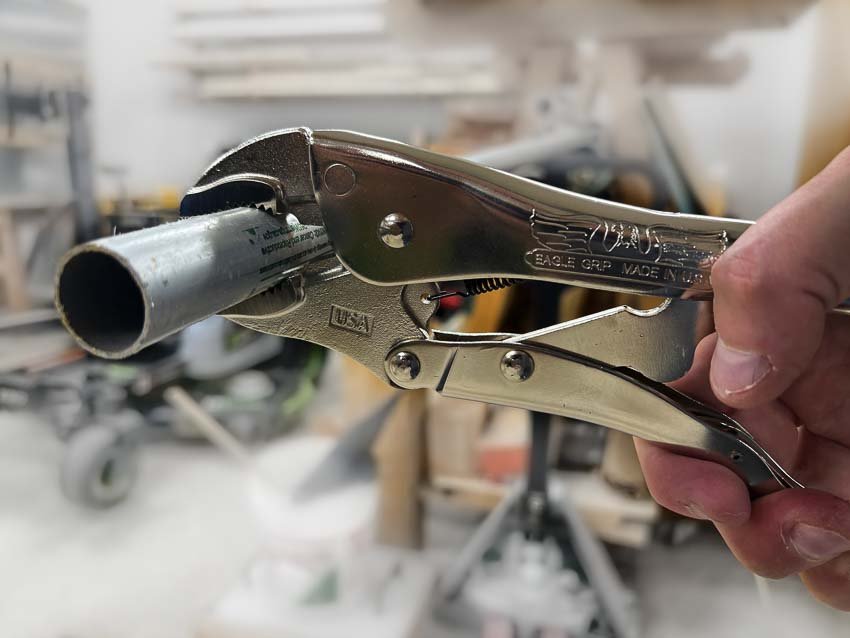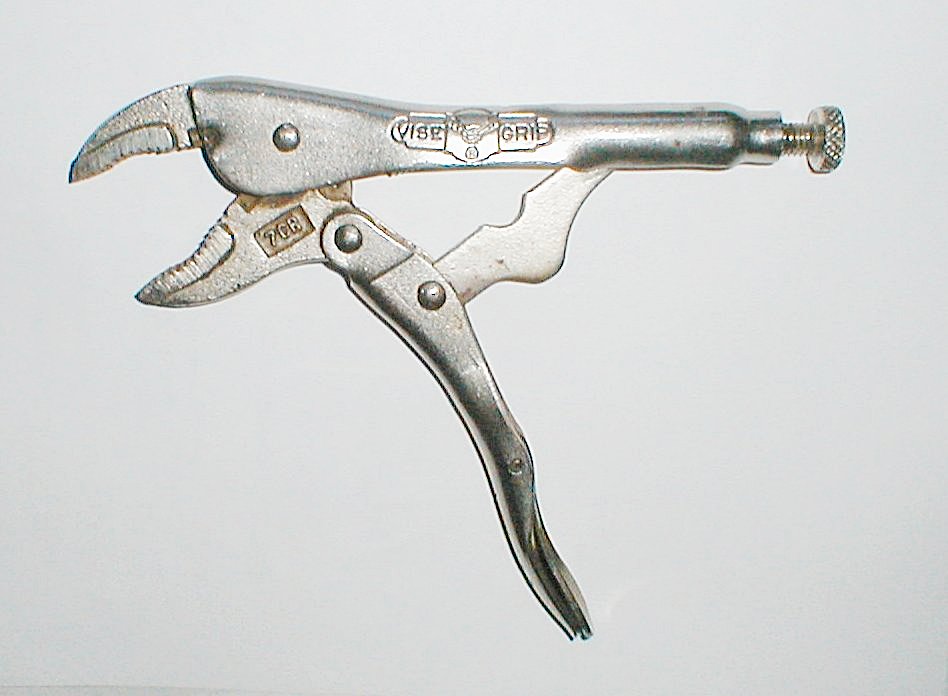Locking pliers can be used by squeezing the handles to grip an object tightly, then engaging the locking mechanism. Adjust the screw for different sizes and release the lock to free the object.
Locking pliers, often known as vice grips, are versatile tools ideal for gripping, twisting, and turning. Their design allows for a strong, adjustable hold on various objects, making them essential for DIY enthusiasts and professionals alike.
Whether tackling a home repair or working on a vehicle, these pliers provide a reliable grip.
They excel in situations where regular pliers may slip or fail. Understanding how to properly use locking pliers can enhance your efficiency and precision in various tasks.
This guide will walk you through the essential steps for effective use, ensuring you maximize the tool’s potential while maintaining safety.

Credit: www.gongmaw.com
Introduction To Locking Pliers
Locking pliers are powerful tools for gripping and holding objects securely. They come in various sizes and shapes, making them versatile for many tasks. This guide will help you understand their basics and importance.
The Basics
Locking pliers, often called Vise-Grips, have a unique mechanism. They lock in place, providing a strong grip without constant pressure. Here are some key components:
- Handle: Provides leverage for squeezing and locking.
- Jaw: The gripping part, available in different designs.
- Adjustment screw: Allows you to change the jaw width.
To use them, squeeze the handles together. This action opens the jaws. Place the jaws around the object, then release the handle to lock. Adjust the screw for a better fit.
Why They’re Essential
Locking pliers are essential for many reasons:
| Feature | Benefit |
|---|---|
| Strong Grip | Secures objects without slipping. |
| Versatile Use | Great for holding, twisting, or turning. |
| One-Handed Operation | Easy to use with one hand. |
Locking pliers help in various tasks, such as:
- Repairing broken items
- Holding pieces while welding
- Removing stubborn nuts and bolts
These tools save time and effort. They are a must-have in every toolbox.
Types Of Locking Pliers
Locking pliers come in various shapes and sizes. Each type serves a different purpose. Understanding the types helps you choose the right tool for your task.
Straight Jaw
Straight jaw locking pliers are versatile. They offer a flat gripping surface. This type is ideal for:
- Gripping flat objects
- Holding large items firmly
- Clamping materials together
These pliers excel in tasks like:
- Welding
- Assembly work
- Holding pipes
Curved Jaw
Curved jaw locking pliers have a unique design. The curved edges grip round objects securely. They are perfect for:
- Pipe work
- Removing stubborn nuts and bolts
- Holding irregularly shaped items
Common uses include:
- Automotive repairs
- Plumbing tasks
- General maintenance
Long Nose
Long nose locking pliers are specialized tools. They have extended jaws for reaching tight spaces. Use them for:
- Precision gripping
- Working in confined areas
- Holding small components
Ideal tasks include:
- Electrical work
- Crafting
- Jewelry making
Setting Up Your Pliers For Use
Locking pliers are versatile tools. Proper setup ensures they work effectively. Follow these steps for optimal use.
Adjustment Mechanisms
Understanding the adjustment mechanism is key. This allows you to customize the grip.
- Adjusting Screw: Located at the handle. Turn it to change the jaw width.
- Release Lever: Found at the base. Press it to open the jaws easily.
To adjust:
- Open the pliers fully.
- Turn the adjusting screw until the desired width is reached.
- Close the pliers to check the fit.
Ensuring A Secure Fit
A secure fit is essential for effective gripping. Follow these steps to ensure it:
- Place the pliers around the object.
- Adjust the screw for a snug fit.
- Press the release lever to lock in place.
Check the grip before use:
| Grip Check Step | Action |
|---|---|
| 1 | Test the grip by squeezing the handles. |
| 2 | Ensure the object does not slip. |
| 3 | Adjust if necessary for a tighter grip. |
With these steps, your locking pliers will work effectively. Enjoy using your tools with confidence!

Credit: m.youtube.com
Effective Techniques For Different Materials
Locking pliers are versatile tools. They can work on various materials. Each material requires different techniques. Here are effective ways to use locking pliers for metal, plastic, and wood.
Metal
Locking pliers grip metal securely. Follow these steps for best results:
- Ensure the area is clean.
- Adjust the pliers to fit the metal piece.
- Apply even pressure while locking the grip.
- Use a gentle rocking motion to loosen tight parts.
Tip: Use locking pliers with rubber grips for better control. This helps prevent slipping.
Plastic
Using locking pliers on plastic needs care. Here are some techniques:
- Choose pliers with a smooth jaw to avoid damage.
- Set the pliers to a gentle grip.
- Test the grip on a scrap piece first.
- Apply pressure slowly to avoid cracking the plastic.
Tip: Use a piece of cloth between the pliers and plastic. This protects the surface.
Wood
Locking pliers work well with wood. Follow these methods:
| Technique | Description |
|---|---|
| Grip Adjustment | Set the grip to avoid crushing the wood. |
| Pressure Control | Apply steady pressure to hold pieces together. |
| Remove Splinters | Use pliers to pull out small splinters. |
Tip: Always use pliers with a padded grip. This enhances comfort and control.
Safety First: Using Locking Pliers Securely
Using locking pliers can be very helpful. They grip objects tightly. Safety is important. Follow these tips to use them securely.
Protective Gear
Wearing the right protective gear is essential. It keeps you safe from accidents. Here are some items to consider:
- Safety glasses: Protects your eyes from debris.
- Gloves: Provides a better grip and protects hands.
- Steel-toed boots: Protects feet from heavy tools.
Avoiding Common Mistakes
Many people make mistakes while using locking pliers. Avoid these to stay safe:
- Check the grip: Ensure the pliers are secure before use.
- Avoid over-tightening: This can damage the object.
- Keep hands clear: Always keep fingers away from the jaws.
- Use the right size: Choose the correct size for the job.
Following these tips ensures safety and effectiveness. Locking pliers are great tools. Use them wisely.

Credit: en.wikipedia.org
Maintenance And Care
Locking pliers are essential tools. Proper maintenance and care extend their lifespan. Regular cleaning and correct storage are key steps.
Cleaning Tips
Keeping your locking pliers clean is crucial. Dirt and grime can affect their performance. Follow these simple steps:
- Use a brush: A small brush removes dirt from crevices.
- Soap and water: Clean the jaws with soapy water.
- Dry thoroughly: Use a cloth to dry them completely.
- Lubricate moving parts: Apply a few drops of oil to hinges.
Inspect the pliers for rust. Rust can weaken the tool. Use sandpaper to remove light rust. Apply oil afterward to protect the metal.
Storage Solutions
Proper storage keeps locking pliers in good shape. Follow these tips for effective storage:
| Storage Method | Description |
|---|---|
| Toolbox | Store pliers in a dedicated toolbox. This keeps them safe. |
| Magnetic strip | Hang pliers on a magnetic strip. This saves space. |
| Pouch | Use a protective pouch. It prevents scratches and damage. |
Keep pliers away from moisture. Humidity can cause rust. Choose a dry area for storage.
Troubleshooting Common Issues
Locking pliers are handy tools but can face problems. Understanding these issues helps you fix them quickly. Below are common problems and their solutions.
Loose Grips
Loose grips make locking pliers ineffective. Here are some causes and fixes:
- Wear and Tear: Over time, parts may wear out.
- Improper Adjustment: Incorrect settings lead to weak grips.
To resolve loose grips:
- Check Adjustment: Ensure the adjustment knob is tight.
- Inspect Jaws: Look for damage or wear.
- Replace Parts: Change worn-out components.
Stuck Adjustments
Stuck adjustments can prevent proper use. Here are some reasons why this happens:
- Rust: Rust can cause parts to seize up.
- Dirt Build-Up: Grime can block moving parts.
To fix stuck adjustments:
- Clean the Tool: Use a brush to remove dirt.
- Apply Lubricant: Use oil to free stuck parts.
- Tap Gently: Lightly tap the adjustment knob.
Advanced Applications
Locking pliers are versatile tools. They excel in many advanced applications. Here, we explore two key areas: welding projects and automotive repairs.
Welding Projects
Locking pliers are essential in welding tasks. They provide a firm grip on metal pieces. This stability is crucial for accurate welding.
- Secure Workpieces: Hold metal parts tightly in place.
- Heat Resistance: Made from durable materials that withstand high temperatures.
- Ease of Use: One-handed operation allows for quick adjustments.
Follow these steps for using locking pliers in welding:
- Select the right size of locking pliers.
- Adjust the pliers to fit the workpiece.
- Lock the pliers securely.
- Proceed with the welding task.
Automotive Repairs
Locking pliers play a key role in automotive repairs. They help in various tasks, from holding parts to removing stubborn fasteners.
| Task | Benefit |
|---|---|
| Holding hoses | Prevents leaks during repairs. |
| Removing bolts | Provides extra grip on rusted bolts. |
| Aligning parts | Ensures precise fitting of components. |
Use these tips for automotive applications:
- Choose the right pliers: Size matters for effective grip.
- Apply consistent pressure: Avoid damaging the parts.
- Inspect regularly: Ensure the tool functions properly.
Frequently Asked Questions
- How Do I Adjust Locking Pliers?
To adjust locking pliers, simply turn the screw at the handle to widen or narrow the jaw opening as needed.
- What Materials Can I Grip With Locking Pliers?
Locking pliers can grip various materials, including metal, wood, and plastic, making them versatile for many tasks.
- Can Locking Pliers Replace A Wrench?
Yes, locking pliers can effectively replace a wrench for gripping and turning nuts and bolts in many situations.
- How Do I Release Locking Pliers?
To release locking pliers, pull the lever located near the handle to disengage the locking mechanism.
- Are Locking Pliers Safe To Use?
Locking pliers are safe when used correctly, ensuring proper grip and avoiding excessive force that could cause slipping.
Conclusion
Locking pliers are versatile tools for any DIY enthusiast. They offer strong grip and secure hold for various tasks. Proper usage ensures safety and efficiency.
Remember to adjust the jaws for different sizes. With practice, you’ll master their use. Start incorporating locking pliers into your toolkit today for improved projects!
Recent Posts
Maintaining clean gutters is essential for preventing water damage to your home, and choosing the best ladder for cleaning gutters can make the job much easier and safer. With so many options on the...
Best Ladder for Cleaning Caravan Roof: Top Picks for You Every Adventure!
Today we will discuss the best ladder for cleaning caravan roof. Cleaning caravan roofs is one of the crucial tasks.After many days, a caravan roof can get dirty by debris, dirt, and grime. These can...
